Since a visit to Cleveland in mid-2019, it has been my intention to share a few observations about the city (or the part I visited, mostly on the shore of Lake Erie and what is generally referred to as Cleveland’s “historic downtown”). I had been to Cleveland before, at least twice, both times on business. But for some reason, on past visits my attention had been limited to my work, and I don’t remember much thought being given to the specific parts of the city where I did my work. So I had never been introduced to the charms of downtown Cleveland. Now, with the city about to be in the news again (as the site of the presidential debate next Tuesday), it is appropriate to tell a little about what I discovered.
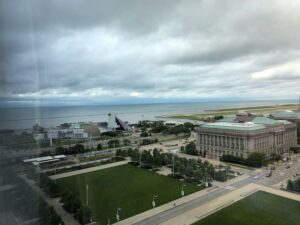
I especially enjoyed the 2019 visit, and part of the reason had to do with a large rebuilding and urban renewal project undertaken a few years back. Since 2010, Cleveland has experienced dramatic economic and population growth, generally attributed to its having become a national leader in environmental protection with its successful cleanup of the Cuyahoga River. (Of course, there’s also the press the city received as a result of the success of “Hot in Cleveland” with Betty White et al.)
And not to be discounted, the choice of Cleveland in 2014 as the site of the Republican Party’s Convention for 2016 might have contributed to some of the change, for locating the convention in Cleveland brought an upsweep of attention and economic activity. This included the construction of three important structures using cash from a quarter-percent sales-tax increase levied by the county to pay for the new $465 million Huntington Convention Center of Cleveland, the adjacent Global Center for Health Innovation, and the $272 million Hilton Cleveland Downtown Hotel, built by Cuyahoga County and noted in the local press in April 2015 as being on track to be finished in time for the convention. All three structures are connected below grade, making for easy access and foot traffic among them all.
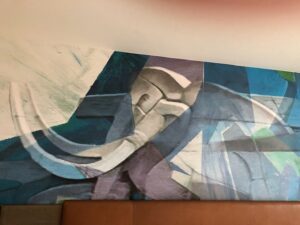
Not that all of this information is directly related to the real purpose of this post, which is to describe Cleveland’s local Art Nouveau masterpiece. But it permits an interesting aside. I’m not sure if it was coincidental or planned, but in our hotel room high up near the top of the Hilton Cleveland Downtown Hotel was a unique decoration which I liked very much. Those readers who know me will appreciate why I take note of it, and why I liked it so much, for over the headboard of the bed this splendid, almost-abstract elephant was painted on the wall. I took it to be a fresco, considering some of the unevenness of the way the color spreads out, but that doesn’t matter. It could have been painted on canvas or other fabric, and there it was. An elephant in my room in a hotel in Cleveland, Ohio! Whether this decorative motif had been in only this room or simply part of a pattern of decoration in other rooms throughout the hotel, I don’t know. And whether this specific decoration had anything to do with the advancing troops of Republican conventioneers, that, too, I do not know, but it provided us with great fun and much comment!
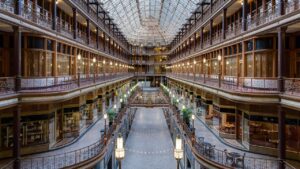
It’s the Arcade in Cleveland’s “historic downtown” that really struck my fancy (imagine: both an elephant painting in my hotel room and this splendid Victorian-era structure, reminding me of all the curves and botanical shapes and arched windows I had seen in many other parts of the world – what more could I ask?). The building known as “The Arcade” is a structure made up of two nine-story buildings, with a five-story arcade (hence the name) joining them. There is a 300-foot arched glass skylight beneath which are four balconies along the walkway around the interior of the space (and, while we’re having fun with numbers, the skylight is 100 feet high and contains more than 1,800 panes of glass). Built in the late 1880s and opening on our American Memorial Day in May 1890, the Cleveland Arcade is commonly thought of as one of the earliest indoor shopping malls in America. It was designated a National Historic Landmark in 1975.
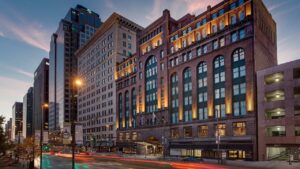
The Arcade was built by the Detroit Bridge Company, under the leadership of Stephen V. Harkness. It was designed by John Eisenmann and George H. Smith and remains one of the few arcades of its kind in the United States. Obviously intended to reflect the Galleria Vittorio Emanuele II in Milan, the Arcade was clearly an engineering masterpiece. The design reflects that as, at the same time, it focuses on the beauty of the Art Nouveau style, at that time blooming forth throughout the world’s architectural and design studios. And while there are certain attributes and elements that we traditionally associate with “American” Art Nouveau (think about the eye-catching glassware of Louis Comfort Tiffany’s lamps or Louis Sullivan’s Transportation Building, with its “Golden Door” entrance and other Art Nouveau detail, at the World’s Columbian Exposition in Chicago in 1893).
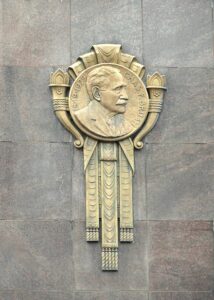
Entrance to The Arcade
Yet this Art Nouveau is not so different from what we know from elsewhere, not so “American.” In fact, if we think about the designs of the handles of the stairwells, the light fixtures, the glass ceiling, and similar elements, we might even go so far as to appreciate the Arcade Art Nouveau as not so much a distinct American style as an adaptation – we might call it – of what was being put forward throughout most of Europe at the time. Distinct, yes, and at the same time, stunningly beautiful to look at, as well as easy to walk around thanks to its thoughtful design. Indeed, from what we’ve learned about Art Nouveau in so many different places, we can almost see a lovely reflection of the medallions on one of Viennese architect Otto Wagner’s famous apartment houses in the medallions located at the entrance to the Arcade, these honoring S.V. Harkness, noted above as the head of the Detroit Bridge Company and Charles F. Brush, American engineer, inventor, entrepreneur, and philanthropist, also heavily involved in the construction of the Arcade and in particular with the financing as the project moved forward (along with such other financiers as John D. Rockefeller, Marcus Hanna, and other wealthy Clevelanders).
In 2001, Hyatt redeveloped the Arcade into Cleveland’s first Hyatt Regency hotel, occupying the two towers and the top three floors of the atrium area. The two lower floors of the atrium remain open to the public with retail merchants, a food court, and restaurants.
Leave a Reply